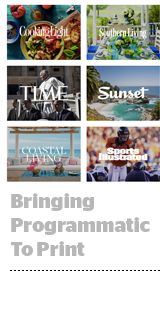 After launching programmatic print in February, Time Inc. on Friday unveiled a new phase of the sales initiative. It adds 12 audience categories to the original half dozen.
After launching programmatic print in February, Time Inc. on Friday unveiled a new phase of the sales initiative. It adds 12 audience categories to the original half dozen.
Media planners can purchase new audience segments across 18 of Time Inc.’s US brands, including sport enthusiasts, travelers, fashion followers, moms and foodies. By doing so they can reach audiences ranging from 15 million to 46 million readers within each of those segments.
Programmatic print, with early interest from advertisers like Target, has gained speed quicker than Time Inc. expected.
Andy Blau, the Time Inc. SVP who oversees programmatic print, said advertisers have already purchased more than a million dollars of inventory, and Time Inc. expects a year-end total of several million.
“We wanted to take advantage of the momentum we have in [digital] programmatic and consider, ‘How do we make print equally accessible to all buyers?’” Blau said of the original decision to create programmatic print.
The goal is to make print accessible to more types of buyers, especially digital ones. Blau said the buying method has already attracted buyers who haven’t bought print ads before with Time Inc.
To buy a Time Inc. print ad programmatically, buyers log into Time Inc.’s DSP partner, MediaMath, to see audience and pricing data. CPMs vary depending on the audience, but they’re more affordable than digital buyers might think.
For instance, a page in People costs $347,000, but across an audience of 42 million, that’s an $8.12 CPM, Blau noted, equivalent to a mid-range CPM on digital. “It’s an extremely efficient vehicle, which was a shocking thing to [the Time Inc.] digital staff” Blau trained.
Time Inc., on its end, fulfills audience buys for segments such as “pet lovers” by placing ads across magazines that overindex in the category. The data comes from consumer surveys carried out by MRI, a third-party magazine measurement company.
Time Inc. chooses where to run the buy to meet the audience requirements – placing ads in half of the magazines, for example, if it needs to slice and dice the audience.
MRI verifies advertisers reached their audience when the ads run six to eight weeks after the buy. It also tells advertisers where the ads ran.
“Using their first-party data to target consumers who meet our demographic criteria represents a giant step in the evolution of print buying,” said Ginger Taylor White, EVP and managing director of publishing investment for Amplifi US and Dentsu Aegis.
Programmatic print isn’t completely automated. Time Inc. says its salespeople were key to getting the word out about the offering.
One reason for their enthusiasm was a change in compensation structure. Prior to the beginning of this year, the company’s 700 salespeople received bonuses for programmatic sales. Now, it counts toward their sales targets.
“Executing programmatic deals is easier than IO [insertion order] advertising, but the selling process is not that different,” Blau said. “We still believe that salespeople are critically important in the world of programmatic. We need people on the street telling buyers about Time Inc.’s brand portfolio.”
As programmatic print gains traction, Time Inc. expects other magazine media companies to experiment with the idea, and it welcomes competition on the theory that more entrants will create a marketplace.
Technology exists to create even more granular targeting for programmatic print in the future.
Via selectable binding, which can bind different magazines down to the subscriber level, advertisers can slot in ads to reach only who they want to reach. Programmatic print 3.0 will bring in an advertiser’s data or third-party data along with Time Inc.’s first-party data to create hypertargeted audiences.
The big hurdle isn’t targeting or delivering such campaigns, but measuring them accurately. MRI is working on that issue now. Time Inc. expects tests of programmatic print 3.0 to happen as early as next year.
“The technology has been around for along time, but we didn’t have large-scale DMPs and the ability to merge data then,” said Blau. “That will be the ultimate in addressable media.”












